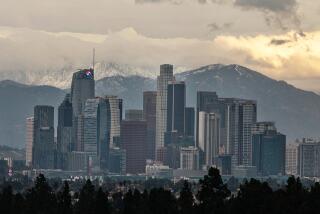Moody’s Sees Record Junk Bond Defaults
- Share via
NEW YORK — Defaults on corporate bonds will hit their highest rate since the Great Depression of the 1930s, as the weak economy saps the ability of companies to keep up on their heavy debt loads, Moody’s Investors Service Inc. predicted in a report released Tuesday.
Moody’s said it expects defaults on junk bonds, which are known as speculative-grade corporate bonds, will reach a record 11.5% by year-end, well above the 8.8% rate of 1990.
The company, one of the main bond-rating bodies, looked at the substantial debt loads of many companies and the financing problems they face, particularly amid the grim economy and credit crunch, said Moody’s economist Jerome Fons.
“The climate has not been very conducive to shedding junk debt, and alternative sources of financing just haven’t been forthcoming,” Fons said.
Companies that took on huge debts in the late 1980s now cannot find sources of capital, he said.
“The market just hasn’t been there,” he said. “People are more leery because of the economy of more companies defaulting.”
Those who fueled the junk bond rage in the 1980s, when the high-yield, high-risk bonds became a popular tool for corporate takeovers, are keeping a lower profile, he said.
“Capital-constrained banks and insurance companies have not led the charge to refinance highly leveraged deals nor have they provided financing to spark the asset sales required to support many struggling firms,” Fons said.
As evidence, Moody’s looked at the number of downgraded credit ratings, Fons said.
“Essentially, credit ratings are default forecasts. Thus, as more issuers are downgraded, default rates rise,” he said.
In the first half of 1991, Moody’s downgraded 156 bond issuers into speculative grades known as junk bonds. Only 39 issuers were upgraded within the junk category or to investment grade.
“The rapid pace of rating downgrades witnessed in 1990 has begun to slow in 1991 but still remains high by historical standards, and the list of issuers with the lowest ratings continues to grow,” Fons said.
Speculative-grade bond defaults hit 11.4% for the 12 months ended in July, Moody’s noted.
The projected default rate of 11.5% for the year would exceed the post-World War II record of 10.9% set in 1970, caused by the default of Penn Central Railroad and its 30 affiliates, Moody’s said.
The record for the century was set in 1933, when an estimated 5.7% of all corporate bond issuers defaulted, Moody’s said. The market for junk bonds during the Depression, however, was so small that a separate default rate isn’t available, Fons said.
Despite signs of recovery, the economy will continue to prey on the junk bond market, Fons added.
“The weak economy, though now showing signs of rebounding somewhat, has contributed to large operating losses at many firms,” he said. “Moreover, default rates have historically tended to remain high for some months, even after a recovery is already clearly under way.”
The junk bond market collapsed at the end of the 1980s, as more and more companies could not cover their debt payments.
Also, Moody’s forecast a 2.7% default rate for all corporate bond issuers, down from the recent high of 3.2% in 1970 and the estimated record of 5.7% in the Depression.
More to Read
Inside the business of entertainment
The Wide Shot brings you news, analysis and insights on everything from streaming wars to production — and what it all means for the future.
You may occasionally receive promotional content from the Los Angeles Times.









